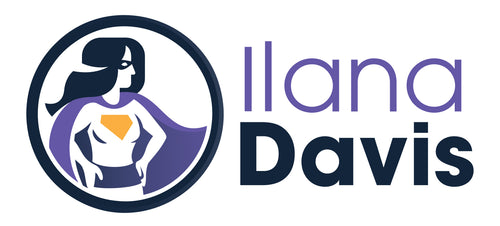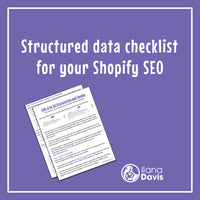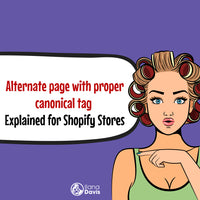Minimize SEO issues when publishing new themes
Treat your theme change as a big effort. Don't roll a bunch of other tasks into your theme change in hopes to knock them all out at once. I recommend focusing on one thing at a time so that you can see where issues arise and know how to fix them.
That means I don't recommend optimizing your SEO, running A/B tests, launching a new product, or looking for ways to improve conversion rates while also launching a new theme. (There are of course caveats and if you have a solid team who know what they are doing, the risks may be reduced.)
Can Shopify theme changes impact SEO?
It's common for Shopify merchants to publish new themes as they head into their busy season.
What they may not realize is that theme changes can absolutely impact your SEO and you should be prepared for such. So let's talk about the best ways to launch a new theme while keeping SEO problems to a minimum.
Understanding what's changing technically is perhaps the hardest part of publishing a new theme, especially if you are not a technical person.
When you change themes it's possible to see changes in rankings, search results, search enhancements, and traffic. Even a small update from your current theme provider can alter your SEO.
This article can be helpful for many situations including if you're
- migrating from one platform to another,
- moving from Shopify 1.0 to a Shopify 2.0 theme,
- downloading an update from your current theme provider, or
- changing themes from one provider to another.
URL changes
The most common example is when themes move from collection-aware URLs to product only URLs. A collection-aware URL means that we know which collection the customer came from.
Collection-aware URLs look something like this: /collections/mens-watches/products/example-1234
Whereas product only URLs look more like this: /products/example-1234
One of the biggest complaints about Shopify over the years is that you couldn't remove the collection-aware URLs, but now you can. Many themes and SEO experts are removing the collection-aware URLs for improved indexing, reducing duplicate content, and helping search engines understand the content better.
If you go this route or your new theme automatically removes the collection-aware URLs, first check on your current setup. If you currently have collection-aware URLs, you'll want to set up redirects to prevent 404 errors as soon as you launch the new theme.
URL changes can go beyond collection URLs. If you're removing pages, make sure you prepare by setting up redirects. Check for new 404 errors in Search Console or your SEO tool of choice as part of your SEO maintenance plan.
Title tag and meta descriptions
Double-check that your new theme has the title tag and meta descriptions. It sounds silly because you would think this is an obvious thing for themes, but you'd be surprised.
You can check for title and meta description tags by viewing the preview of the theme. Then right-click anywhere on the page and go to View Source. Look for <title> and <meta name="description". Both should match what you've entered into the Search engine listing preview section for your page.
If these tags are missing or they don't match what you've entered, contact your theme provider. If you have an SEO app that replaces your theme title and description tag, check with them as well.
Ensure alt text is present
Anytime you upload an image into Shopify, you should be adding the alternative text. Alt text is used both by search engines and visually impaired users.
Shopify has instructions on how to add alt text to your product media.
Once you've added the alt text, you'll want to make sure the alt text is showing up in the code. Don't worry, you don't have to get into the code for this.
Many SEO tools like Screaming Frog will scan through your website and let you know if images are missing your alt text.
Semantic headings
Semantic, meaning a logical order of your heading structure, can help Google to understand the structure of the page. Search engines will use your heading structure to distinguish from different sections of your page.
This is an area where many themes frankly suck. So it's up to you to use the proper formatting in the description of your pages.
Google often looks at the first heading on the page which should be an h1 or h2 but they will analyze the entire page when evaluating the content.
Your page structure might look something like this:
heading 1
heading 2
paragraph
heading 2
paragraph
heading 3
paragraph
and so on ...
Content changes
I'm sure this sounds strange but bear with me.
If possible, keeping your content as similar as possible can help your SEO. Small content tweaks are likely ok.
When I say content, I mean everything visually on your page, not just the page description. That includes your navigation menus, images, and section content.
Your link depth should also be the same. If you're linking to a product on the homepage, make sure that link is there in the theme update. If it takes me 3 clicks to get to a product, it should still take me 3 clicks. If you have quickview on your old theme, make sure it's on your new theme as well. This applies to all pages (collections, blogs, pages..) not just your homepage.
When your content remains more or less the same, you know any traffic or ranking issues are not content related.
There are enough technical changes with a theme change and keeping the content as is helps to narrow down where the issue may be.
Unless it's urgent, I recommend waiting for a month or two after your theme change before updating content.
Theme performance
I'm not one to focus on site speed because I think people put too much emphasis on the scores they get from Google. But I do think it's important to understand the performance of the theme before and after.
Run your site through Pingdom or if you must, Lighthouse, just to understand how it performs. It's hard to test on an unpublished theme so you can run the demo from the new theme through the same tool. It won't be apples to apples but you'll at least get an idea of potential issues. After publishing your new theme, run it through as well.
The biggest impact on speed is often apps so keep that in mind when evaluating the page load time.
Don't forget to read through the theme docs and take note of their image size recommendations. Most new themes in Shopify should be using Shopify's CDN. If so, Shopify will compress images for you, but only if they are using the CDN.
Structured data
Themes are required to provide the schema markup needed to qualify for search enhancements such as Rich Results. But they are only required to include the product markup. Shopify doesn't require that it be high qualify or ensure that it's complete. They also don't require themes to include the other types of markup that can be used for Rich Results.
When you publish a new theme, it's highly likely you'll see critical or non-critical issues in Search Console.
If you're one of the lucky ones to see issues in Search Console, don't panic.
Read through the issues Search Console finds. If you're seeing issues in your Merchant Listings or the Enhancements section, it's possible your theme structured data has issues that need to be resolved. You can use this article to help you test your structured data to understand where the issues may be coming from.
JSON-LD for SEO customers with the app enabled can usually ignore any of those issues as we've got you covered. You are always welcome to email me to put your mind at ease.
If you're not a JSON-LD for SEO customer, contact me for a free structured data audit. I'll tell you if you can ignore the issues or if the JSON-LD for SEO app would be a fit for you.
JSON-LD for SEO
Get more organic search traffic from Google without having to fight for better rankings by utilizing search enhancements called Rich Results.
Linking Llama
Link discontinued products to their best substitute. Keep discontinued products published on your website and continue to benefit from traffic to these pages.




